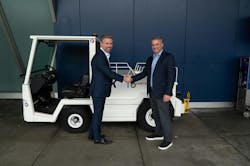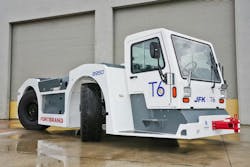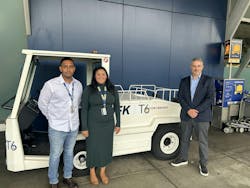JFK Terminal 6 Ushers in First-Ever Pooled Electric GSE Fleet in North America
When construction crews finish the sweeping glass façade of John F. Kennedy International Airport’s new Terminal 6 (T6), the passengers passing through will see the latest in architecture and design. But for those working on the apron, the real innovation will be happening out of view.
With the first gates set to open in 2026, T6 will debut as the first North American terminal to operate a pooled, all-electric fleet of ground support equipment (GSE). The plan, developed by JFK Millennium Partners (JMP) in partnership with the Port Authority of New York and New Jersey (PANYNJ) and operated by Fortbrand Services, reimagines how airlines and handlers interact with the very tools that keep aircraft moving.
Instead of each airline or ground handler deploying its own tractors, belt loaders, and GPUs onto the ramp, all operators at T6 will tap into a centralized pool of electric equipment owned, maintained, and managed by Fortbrand. The aim: cut emissions, reduce duplication, streamline safety, and set a new baseline for efficiency.
“This initiative is a game changer,” said Steve Thody, CEO of JFK Millennium Partners. “At JFK Terminal 6, we’ve had the opportunity to start fresh and reimagine how operations on the ramp should look. Pooling ground service equipment and making it fully electric brings together safety, efficiency, and sustainability in a way that hasn’t been done before in the U.S.”
Jared Verano, CEO of Fortbrand Services, echoed the sentiment. “Fortbrand is proud to be part of this groundbreaking operation at JFK T6,” he said. “As a New York-based company with more than 40 years in the industry, it means a lot to contribute to the first all-electric ground service pooling operation in the United States.”
Why pooling matters
The idea of pooling GSE isn’t new. Europe has been experimenting with shared fleets for years. The results have shown promise: less congestion, lower capital investment, and more predictable maintenance schedules.
But transplanting the model into the U.S. is no small task. Here, airlines and their contracted handlers have long controlled their own fleets, tailoring them to individual preferences and managing maintenance internally. Changing that DNA means untangling decades of ingrained practices.
Rick Cotton, Executive Director of PANYNJ, framed the move as part of a broader climate and operational strategy. “The Port Authority’s nation-leading commitment to achieve net-zero emissions by 2050 includes a transition to the use of all commercially available zero-emission ground support equipment at the region’s airports,” he said. “The agreement between JFK Millennium Partners and Fortbrand to serve Terminal 6 with shared electric ground support equipment represents an exciting step toward reaching our goal.”
At full build-out, the T6 electric fleet is projected to cut about 2,500 metric tons of CO₂ annually - the equivalent of driving a gasoline car six million miles.
Verano pointed out that while adoption of electric GSE has been slow, pooling and infrastructure planning at T6 offer a path forward. “Electric equipment adoption has been slowed by infrastructure challenges, but it remains the most environmentally friendly and cost-effective way to service aircraft,” he said. “We’re thrilled to see JFK T6 lead the way.”
A cultural shift for ground handlers
For the ground handling companies preparing to operate at T6, the announcement represents more than just new equipment, it’s a cultural shift in how work on the ramp is organized.
Nic Pierre, Regional Director for Airway LLC, said his team sees it as a chance to lead change rather than resist it. “We are truly excited to be part of this ground-breaking plan to modernize ramp operations,” he explained. “It’s a unique opportunity to help shape the future of how we work, setting a new standard for safety, efficiency, and innovation.”
Pierre acknowledged that sharing equipment will require new habits and communication channels. Traditionally, handlers felt ownership - and responsibility - for their own gear. Now, discipline and coordination will matter more than brand loyalty or proprietary processes.
“Naturally, there may be short-term challenges, particularly with adapting to sharing equipment,” he said, “but I’m confident that with clear communication, teamwork, and strong leadership we will overcome them quickly.”
For frontline staff, Pierre frames the change as positive: an opportunity to work with modern tools and to be part of an industry-first. “This transformation is empowering,” he said. “It provides modern tools, and an opportunity to feel proud of being part of something innovative and industry leading.”
Balancing opportunity and challenge
Other handlers see the same duality — enthusiasm mixed with practical concerns.
Worldwide Flight Services (WFS), which is expanding from its large cargo and express footprint into passenger ramp handling at T6, noted that coordination will be key. “We recognize that any implementation of new plans, technologies, and processes requires careful coordination and adaptation,” the company said in a statement.
For WFS, the chief concern is availability and positioning of equipment during peak periods. “Our focus will be ensuring all stakeholders understand their requirements and responsibilities, guaranteeing that adequate equipment is deployed at the right location and time,” the company said.
Training is also top of mind. While staff will need to learn new procedures and adapt to electric operations, WFS expressed confidence in its team’s ability to adjust while “maintaining the exceptional service quality our customers expect.”
The company sees T6 as a growth opportunity, giving it a foothold in passenger ramp operations while showcasing its ability to collaborate in a shared-resource environment.
Sustainability through collaboration
For dnata, one of the world’s largest handlers, the T6 project is proof that collaboration can advance sustainability while improving daily operations.
“We are proud to be part of the first airport in North America to introduce a shared pool of electric ground support fleet among airlines," said David Barker, dnata’s Regional CEO – Americas. "This innovative model enhances safety, improves efficiency, and reduces environmental impact, showcasing how collaboration across the airport community can drive smarter, more sustainable operations.”
Barker added that dnata will continue to invest in training and infrastructure to deliver “the dnata difference” at T6, positioning the company as a leader in setting new service benchmarks.
Crunching the numbers
Arnold Sue, CEO of ASAK, approached the change with a more analytical lens. He described the initiative as “a true chance for the GHA companies of JFK to showcase our understanding of communal operations.”
Sue pointed to several operational adjustments that will require careful management: user discipline, pricing models for handlers, and labor allocation. He noted that the introduction of telemetry, access control, and unfamiliar equipment types may create learning curves.
Yet, Sue is optimistic about the bottom line. “Not all change is bad,” he said. “This modernization offers operational effectiveness, lower GHA capital expenditure, and reduced maintenance costs.”
Importantly, he stressed that ASAK personnel are well-positioned to adapt, having already worked with many of the projected systems. “Our own personnel will transition with limited hardships,” Sue said, predicting that the company’s focus on labor allocation, training, and service-level agreements would help establish ASAK as a premier GHA at T6.
The infrastructure question
The pooled model requires more than equipment, it demands infrastructure. Each of T6’s 10 gates will be outfitted with dedicated electric GSE, minimizing the need to reposition units across the apron. Charging stations, battery monitoring, and grid capacity must be robust enough to support peak operations.
Thody acknowledged that building charging into the terminal from the start was a critical advantage. “Technology has really been the needle we’ve threaded to make this program work,” he said. “Telematics means we know who’s using the equipment, how it’s being used, and if it’s being used responsibly.”
Verano emphasized that Fortbrand’s long history in New York prepared it for this challenge. “We’ve been serving the New York airports for over four decades, and being part of the first terminal to implement an all-electric pooling operation is especially exciting,” he said. “This represents the future of our industry.”
That visibility will allow Fortbrand not only to enforce accountability but also to generate data on utilization, turnaround times, and maintenance patterns that could help reshape industry best practices.
Looking to the future
The bigger picture extends well beyond JFK. The $19-billion redevelopment of the airport includes not only T6 but also the $9.5-billion New Terminal One, which is likewise planning for common-use electric GSE. Industry observers are watching closely to see whether pooling in New York becomes a template for airports in Los Angeles, Chicago, Dallas, and beyond.
For handlers on the ground, the shift is as much about mindset as machinery. As Pierre of Airway LLC put it, “Looking ahead, I see a very bright future for our company at JFK T6. This modernization positions us as leaders in operational excellence, strengthens our partnerships with airlines, and paves the way for continued growth and new opportunities.”
The consensus is clear: while challenges lie ahead - from training to cost modeling to equipment allocation - the opportunity to modernize ramp operations at scale is too important to pass up.
In Arnold Sue’s words: “With our aggressive focus on labor allocation, training, airline SLA, and understanding of both communal operations and management; I have no doubt that ASAK will be premier GHA at JFK T6.”
A blueprint in the making
Terminal 6 is more than another new terminal in a long airport redevelopment. It is a test case for how the U.S. industry might reinvent ramp operations. If Fortbrand and JMP succeed, pooled electric GSE could become not just a sustainability milestone, but an operational model copied nationwide.
“The eyes of the industry are on us,” Thody said. “Our responsibility is to show that pooling electric GSE works, that it’s safer, more efficient, and more sustainable. And we’re confident it will be.”
Terminal 6 by the Numbers
- Cost of project: $4.2 billion
- Gates at full build-out: 10
- Annual CO₂ savings from pooled electric GSE: ~2,500 metric tons
- Gasoline equivalent: 6 million miles driven by a passenger car
- Opening date for first gates: 2026
- Project partners: JFK Millennium Partners, Fortbrand Services, Port Authority of New York & New Jersey
· Why Pooled GSE?
For the airlines and handlers moving into JFK’s Terminal 6, the pooled ground support equipment model offers a host of advantages.
By dedicating fully electric equipment to each gate, congestion is reduced, movements across the apron are minimized, and the safety of ramp workers is improved. Because the fleet is shared and centrally managed, carriers and ground handlers avoid the capital expense of owning GSE outright, while telematics systems provide accountability and performance data in real time.
Beyond the cost and efficiency gains, the all-electric fleet represents a major step toward the Port Authority’s long-term sustainability goals.




